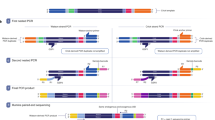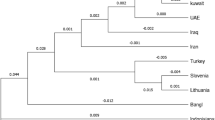Abstract
Accurate analysis of DNA sequence variation in not only humans and animals but also other organisms has played a significant role in expanding our knowledge about genetic variety and diversity in a number of different biological areas. The search for an understanding of the causes of genetic variants and mutations has resulted in the development of a simple laboratory technique, known as the polymerase chain reaction-restriction fragment length polymorphism (PCR-RFLP) method, for the detection of single nucleotide polymorphisms (SNPs). PCR-RFLP allows rapid detection of point mutations after the genomic sequences are amplified by PCR. The mutation is discriminated by digestion with specific restriction endonucleases and is identified by gel electrophoresis after staining with ethidium bromide (EtBr). This convenient and simple method is inexpensive and accurate for SNP genotyping and especially useful in small basic research studies of complex genetic diseases. The whole protocol takes only a day to carry out.
This is a preview of subscription content, access via your institution
Access options
Subscribe to this journal
Receive 12 print issues and online access
$259.00 per year
only $21.58 per issue
Buy this article
- Purchase on Springer Link
- Instant access to full article PDF
Prices may be subject to local taxes which are calculated during checkout



Similar content being viewed by others
References
Saiki, R.K. et al. Enzymatic amplification of β-globin genomic sequences and restriction site analysis for diagnosis of sickle cell anemia. Science 230, 1350–1354 (1985).
Saiki, R.K., Bugawan, T.L., Hron, G.T., Mullis, K.B. & Erlich, H.A. Analysis of enzymatically amplified β-globin and HLA-DQα DNA with allele-specific oligonucleotide probes. Nature 324, 163–166 (1986).
Mullis, K.B. & Faloona, F.A. Specific synthesis of DNA in vitro via a polymerase-catalyzed chain reaction. Methods Enzymol. 155, 335–350 (1987).
Collins, F.S., Brooks, L.D. & Chakravarti, A. A DNA polymorphism discovery resource for research on human genetic variation. Genome Res. 8, 1229–1231 (1998).
The International HapMap Consortium. The international HapMap project. Nature 426, 789–796 (2003).
Martin, E.R. et al. SNPing away at complex diseases: analysis of single-nucleotide polymorphisms around APOE in Alzheimer disease. Am. J. Hum. Genet. 67, 383–394 (2000).
de Bakker, P.I.W. et al. A high-resolution HLA and SNP haplotype map for disease association studies in the extended human MHC. Nat. Genet. 38, 1166–1172 (2006).
Pearson, J.V. et al. Identification of the genetic basis for complex disorders by use of pooling-based genomewide single-nucleotide-polymorphism associated studies. Am. J. Hum. Genet. 80, 126–139 (2007).
Goldstein, D.B., Ahmadi, K.R., Weale, M.E. & Wood, N.W. Genome scans and candidate gene approaches in the study of common diseases and variable drug responses. Trends Genet. 19, 615–622 (2003).
Ahmadi, K.R. et al. A single-nucleotide polymorphism tagging set for human drug metabolism and transport. Nat. Genet. 37, 84–89 (2005).
Delrieu, O. & Bowman, C. Visualizing gene determinants of disease in drug discovery. Pharmacogenomics 7, 311–329 (2006).
Syvanen, A.C. Accessing genetic variation: genotyping single nucleotide polymorphisms. Nat. Rev. Genet. 2, 930–942 (2001).
Shriver, M.D. et al. Large-scale SNP analysis reveals clustered and continuous patterns of human genetic variation. Hum. Genomics 2, 81–89 (2005).
Hacia, J.G. et al. Determination of ancestral alleles for human single-nucleotide polymorphisms using high-density oligonucleotide arrays. Nat. Genet. 22, 164–167 (1999).
Kidd, K.K. et al. Developing a SNP panel for forensic identification of individuals. Forensic Sci. Int. 164, 20–32 (2006).
Iwasaki, H. et al. Accuracy of genotyping for single nucleotide polymorphisms by a microarray-based single nucleotide polymorphism typing method involving hybridization of short allele-specific oligonucleotides. DNA Res. 9, 59–62 (2002).
Papp, A.C., Pinsonneault, J.K., Cooke, G. & Sadee, W. Single nucleotide polymorphism genotyping using allele-specific PCR and fluorescence melting curves. Biotechniques 34, 1068–1072 (2003).
O'Meara, D., Ahmadian, A., Odeberg, J. & Lundeberg, J. SNP typing by apyrase-mediated allele-specific primer extension on DNA microarrays. Nucleic Acids Res. 30, e75 (2002).
Pickering, J. Integration of DNA ligation and rolling circle amplification for the homogeneous, end-point detection of single nucleotide polymorphisms. Nucleic Acids Res. 30, e60 (2002).
Chatterjee, P.D. Direct sequencing of bacterial and P1 artificial chromosome-nested deletions for identifying position-specific single-nucleotide polymorphisms. Proc. Natl. Acad. Sci. USA 96, 13276–13281 (1999).
Deng, G.R. A sensitive non-radioactive PCR-RFLP analysis for detecting point mutations at 12th codon of oncogene c-Ha-ras in DNAs of gastric cancer. Nucleic Acids Res. 16, 6231 (1988).
Ota, M. et al. Modified PCR-RFLP method for HLA-DPB1 and –DQA1 genotyping. Tissue Antigens 38, 60–71 (1991).
Livak, K.J., Flood, S.J., Marmaro, J., Giusti, W. & Deetz, K. Oligonucleotides with fluorescent dyes at opposite ends provide a quenched probe system useful for detecting PCR product and nucleic acid hybridization. PCR Methods Appl. 4, 357–362 (1995).
Livak, K.J. Allelic discrimination using fluorogenic probes and the 5′ nuclease assay. Genet. Anal. 14, 143–149 (1999).
Kwiatkowski, R.W., Lyamichev, V., de Arruda, M. & Neri, B. Clinical, genetic, and pharmacogenetic applications of the invader assay. Mol. Diag. 4, 353–364 (1999).
Fors, L., Lieder, K.W., Vavra, S.H. & Kwiatkowski, R.W. Large-scale SNP scoring from unamplified genomic DNA. Pharmacogenomics 1, 219–229 (2000).
Haff, L.A. & Smirnov, I.P. Single-nucleotide polymorphism identification assays using a thermostable DNA polymerase and delayed extraction MALDI-TOF mass spectrometry. Genome Res. 7, 378–388 (1997).
Gunderson, K.L., Steemers, F.L., Lee, G., Mendoza, L.G. & Chee, M. A genome-wide scalable SNP genotyping assay using microarray technology. Nat. Genet. 37, 549–554 (2005).
Abbud, Z.A., Wilson, A.C., Cosgrove, N.M. & Kostis, J.B. Angiotensin-converting enzyme gene polymorphism in systemic hypertension. Am. J. Cardiol. 81, 244–246 (1998).
Simsek, M., Al-Wardy, N., Al-Khayat, A. & Al-Khabory, M. A PCR-RFLP test for simultaneous detection of two single-nucleotide insertions in the Connexin-26 gene promoter. Genet. Test. 6, 225–228 (2002).
Bu, H., Rosdahl, I., Sun, Z.-F. & Zhang, H. Importance of polymorphisms in NF-κBI and NF-κBIα genes for melanoma risk, clinicopathological features and tumor progression in Swedish melanoma patients. J. Cancer Res. Clin. Oncol. 183, 856–866 (2007).
Ota, M., Seki, T., Fukushima, H., Tsuji, K. & Inoko, H. HLA-DRB1 genotyping by modified PCR-RFLP method combined with group-specific primers. Tissue Antigens 39, 187–202 (1992).
Inoko, H. & Ota, M. PCR-RFLP. in Handbook of HLA Typing Techniques (eds. Hui, K.M. & Bidwell, J.L.) 9–70 (CRC Press, Boca Raton, Ann Arbor, London, Tokyo, 1993).
Lee, J.C.-I. & Chang, J.-G. ABO genotyping by polymerase chain reaction. J. Forensic Sci. 37, 1269–1275 (1992).
Roberts, R.J., Vincze, T., Posfai, J. & Macelis, D. REBASE-enzymes and genes for DNA restriction and modification. Nucleic Acids Res. 35, D269–D270 (2007).
Ke, X., Collins, A. & Ye, S. PCR designer for restriction analysis of various types of sequence mutation. Bioinformatics 18, 1688–1689 (2002).
Zhang, R. et al. SNP cutter: a comprehensive tool for SNP PCR-RFLP assay design. Nucleic Acids Res. 33, W489–W492 (2005).
Love-Gregory, L.D., Dyer, J.A., Grasela, J., Hillman, R.E. & Phillips, C.L. Carrier detection and rapid newborn diagnostic test for the common Y393N maple syrup urine disease allele by PCR-RFLP: culturally permissible testing in the Mennonite community. J. Inherit. Metab. Dis. 24, 393–403 (2001).
van Baren, M.J. & Heutink, P. The PCR suite. Bioinformatics 20, 591–593 (2004).
Gardner, S.N. & Wagner, M.C. Software for optimization of SNP and PCR-RFLP genotyping to discriminate many genomes with the fewest assays. BMC Genomics 6, 73 (2005).
Moore, D.D. Purification and concentration of DNA from aqueous solutions. in Current Protocols in Molecular Biology (eds. Ausubel, F.M., Brent, R., Kingston, R.E., Moore, D.D., Seidman, J.G., Smith, J.A. & Struhl, K.) 2.1.1–2.1.9 (John Wiley & Sons, Inc., Hoboken, NJ, USA, 1994).
Roberts, R.J., Vincze, T., Posfai, J. & Macelis, D. REBASE-restriction enzymes and DNA methyltransferases. Nucleic Acids Res. 35, D230–D232 (2005).
Polisky, B. et al. Specificity of substrate recognition by the EcoRI restriction endonuclease. Proc. Natl. Acad. Sci. USA 72, 3310–3314 (1975).
George, J. & Chirikjian, J.G. Sequence-specific endonuclease BamHI: relaxation of sequence recognition. Proc. Natl. Acad. Sci. USA 79, 2432–2436 (1982).
Woodbury, C.P. et al. DNA site recognition and reduced specificity of the EcoRI endonuclease. J. Biol. Chem. 255, 11534–11546 (1980).
Sektas, M., Kaczorowski, T. & Podhajska, A.J. Purification and properties of the MboII, a class-IIS restriction endonuclease. Nucleic Acids Res. 20, 433–438 (1992).
Conlan, L.H., Jose, T.J., Thornton, K.C. & Dupureur, C.M. Modulating restriction endonuclease activities and specificities using neutral detergents. Biotechniques 27, 955–960 (1990).
Author information
Authors and Affiliations
Corresponding author
Rights and permissions
About this article
Cite this article
Ota, M., Fukushima, H., Kulski, J. et al. Single nucleotide polymorphism detection by polymerase chain reaction-restriction fragment length polymorphism. Nat Protoc 2, 2857–2864 (2007). https://doi.org/10.1038/nprot.2007.407
Published:
Issue Date:
DOI: https://doi.org/10.1038/nprot.2007.407
This article is cited by
-
A rapid and inexpensive genotyping method using dried blood spots for mutational analysis in a mutant mouse model: an update
Molecular Biology Reports (2022)
-
Molecular Genetic Techniques in Biomarker Analysis Relevant for Drugs Centrally Approved in Europe
Molecular Diagnosis & Therapy (2022)
-
X Chromosome inactivation: a modifier of factor VIII and IX plasma levels and bleeding phenotype in Haemophilia carriers
European Journal of Human Genetics (2021)
-
Diagnosing the drug resistance signature in Plasmodium falciparum: a review from contemporary methods to novel approaches
Journal of Parasitic Diseases (2021)
-
XRCC1 (rs25487) polymorphism is associated with severe oral mucositis and poor treatment response after radiotherapy for oropharyngeal carcinoma
Oral Cancer (2019)
Comments
By submitting a comment you agree to abide by our Terms and Community Guidelines. If you find something abusive or that does not comply with our terms or guidelines please flag it as inappropriate.



